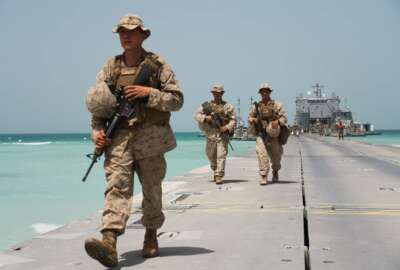
Are planes more intimidating than troops or vice versa?
What scares a potential enemy more: Waves of fighter bombers or massed troops on the ground behind tanks? It's an important question with strategic and budget...
Best listening experience is on Chrome, Firefox or Safari. Subscribe to Federal Drive’s daily audio interviews on Apple Podcasts or PodcastOne.
What scares a potential enemy more: Waves of fighter bombers or massed troops on the ground behind tanks? It’s an important question with strategic and budget implications. New research suggests the U.S. may have it all wrong, as Federal Drive with Tom Temin heard from Dan Grazier, military fellow at the Project on Government Oversight.
Interview transcript:
Tom Temin: Dan Good to have you in.
Dan Grazier: Hey, it’s great to be here.
Tom Temin: So you were looking at a RAND study that looked at perhaps these really expensive, high tech and difficult to maintain and keep operational weapons systems we have now or under development may not have as much deterrent effect as people thought exactly.
Dan Grazier: The RAND study looked at a number of different deployments over the last 70 years or so to determine what force structure would best deter potential adversary for carrying out their ends. And they found, after looking through 21 different crisis deployments, that it was U.S. heavy combined arms ground forces that deterred much better than just sending a couple of squadrons of F-15s or even parking the sixth fleet off in the Mediterranean to conduct potential airstrikes.
Tom Temin: That was Richard Nixon gambit, right?
Dan Grazier: Right, in 1970 the Black September crisis where the United States was trying to deter Syria from invading Jordan.
Tom Temin: And in your own experience in the military, does that seem to ring true to you?
Dan Grazier: That’s definitely relevant here because I was a tank officer in the Marine Corps. So I have a natural preference for for armor, but I’m also a military historian and really, my work, my academic work is focused on air power history on not so much the armor ground warfare history. So this study really confirms a lot of the research that I’ve done over the last couple of years that shows that, look, when we really need to achieve our strategic goals, nothing will substitute a commitment of ground forces.
Tom Temin: And does the military really do you think, in their doctrine, follow that nowadays? Especially, there’s a new doctrine that says we are now back in great power competition. What’s the implication of that? When the great powers they mean Russia and China, right? So far, India is still on our side.
Dan Grazier: For the time being, hopefully they remain that way. For the time being, what the return of great power competition is producing, its justification for buying a lot of F-35s and the B-21, under development in the next couple of years. It justifies the four class aircraft carriers. Now, to a lesser degree, it does also justify the Army’s tank upgrade program. They’re moving now into the M-1, A-2 step version three, which is an interesting program. I have some questions about that one, but the overall message with that is, hey, we need to buy more high technology weapons systems to be able to compete with or pure adversaries.
Tom Temin: Well, could part of the thinking behind the military planners, they have so much money to spend, and it’s growing, but it’s not growing that fast. In some ways, lots of troops poses greater future costs than expensive weapons systems because the cost of the volunteer force is really something I’m not sure they could envisionhow expensive it was when this whole thing was established back in the mid 1970s.
Dan Grazier: That’s true up to a certain extent because yes, veteran care when when you look 20, 30, 40 years down the road, does get very expensive but it’s still pales in comparison to the cost of maintaining a the F-35 fleet, which is expected to cost $1.5 trillion over its life span.
Tom Temin: So reading that RAND report, looking at your analysis as a historian, what do you think budget planners and military planners should take away from this? What should they do differently?
Dan Grazier: Well, with the idea that ground forces are what it takes to achieve a decision of warfare, we need to structure the force around that with that being the case. And it is true when you look through history that is absolutely true. Then your decisions about the type of aircraft that you purchase, that comes into question. So instead of buying a lot of stealth aircraft that are meant to penetrate deep in the defendant enemy airspace, we need to buy more dedicated attack aircraft. We have the A-10 right now. How about we we look at the next the next generation of attack aircraft, so the A-20 or whatever you wanna call it, down the roa. Now that kind of aircraft doesn’t need to be stealthy because working in close cooperation with ground forces.
Tom Temin: People will know it’s there.
Dan Grazier: They’ll know it’s there. The ground forces take a lot of a lot of precautions to protect the protect the aircraft, they’re mutual supporting arms when when they work like that. So the ground forces are conducting suppression of enemy air defense missions to protect the aircraft is they’re coming in to conduct their missions. So you don’t need a very flashy, stealthy aircraft for that. You need a very rugged aircraft that can operate down close with the ground troops that can land close to the ground troops so you can have that direct coordination as much as possible. Now you still need fighter aircraft. I’m not discounting. I’m not discounting that. But with the idea of ground forces being being the most important than that makes attack aircraft the most important type of aircraft, the fighter aircraft to gain air supremacy, local air supremacy, don’t need it all the way to the final objective. You just needed around the actual advancing ground forces, but they become secondary to protect the attack aircraft and then the deep strike aircraft for interdiction. You just need those mostly as a tertiary distraction that try to spread the enemy out as much as possible so they can’t concentrate their air defense assets right up close to the front lines.
Tom Temin: And when you look at tanks and troops, do you think that, you know, is there evidence yet at this point in history that unmanned versions of these, which could be much less expensive? You don’t need a lot of the perhaps armor and soundproofing and so on that you would need with tanks with people inside, that could be operated remotely, not autonomously but remotely. Could that mitigate some of the troop costs and copy costs of such a return to a traditional type of ground force?
Dan Grazier: It’s possible. I’ll be interested to see over the next couple of years, as a lot of these systems are developed, to see the potentiality, I guess about how well how will they work and how effective they’ll be on the battlefield? I do always urge caution with that because those kind of systems need to be networked and they’re prone to cyber attack. So right now the M-1 one tanks that I operated on in the Marine Corps from 2005 to 2015 would be very difficult to hack remotely, so that becomes an issue when you start talking about those remote systems.
Tom Temin: So the bottom line of this Rand study in your analysis then is? How would you summarize it?
Dan Grazier: Well, it’s It should call into question a lot of the decisions that have been made over the years. And it’s it’s really difficult to quantify history, which they trying to dio. But it at least has provoked a useful discussion in and around Washington and kind of shattered some of the the conventional wisdom that has existed around defense matters for a century. Really.
Tom Temin: Dan Grazier is military fellow with the Project on Government Oversight. As always, thanks so much.
Dan Grazier: Thank you for having me.
Copyright © 2025 Federal News Network. All rights reserved. This website is not intended for users located within the European Economic Area.





